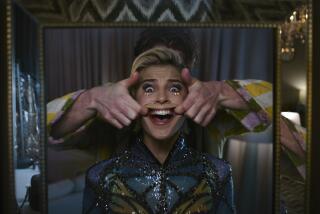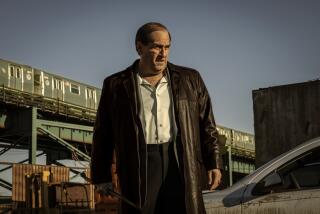Review: An enjoyable ‘Doctor Strange’ sequel delivers the flyin’, the witch and the red robe
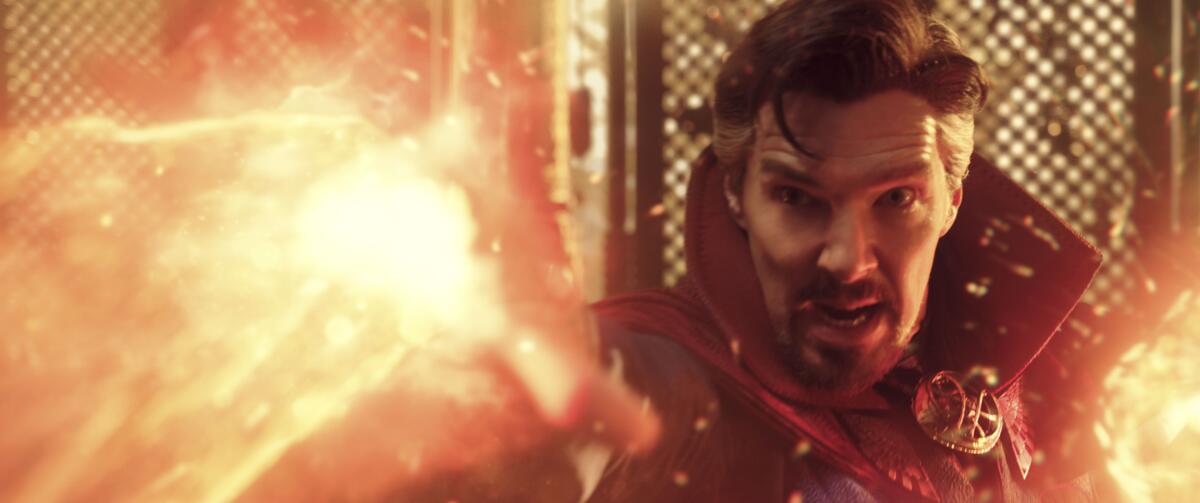
- Share via
Double, double, gargoyles and rubble: There are witchy doings and evil twins aplenty in “Doctor Strange in the Multiverse of Madness,” the spookily unhinged new entry in the Marvel Cinematic — uh, Universe? Multiverse? Whatever we’re supposed to call this increasingly hydra-headed Disney content behemoth, it has rarely ventured in a direction this playful, this ghoulish, this exuberantly grotesque.
That’s another way of saying that the latest Strange brew — full of mangled extremities, gouged eyeballs and other freaky flourishes — is the satisfying handiwork of the director Sam Raimi, whose long-overdue return to feature filmmaking is no less welcome for being tied to Hollywood’s most continually fatted cash cow.
Raimi, of course, comes to this assignment with no shortage of Marvel movie history under his belt. An early throwaway Spider-Man joke gently reminds you that he directed the original Spidey film trilogy (2002-07) for Sony, though he’s steered clear of the many subsequent chapters, including last year’s hugely successful “Spider-Man: No Way Home.” That dizzying adventure, with its trio of Spider-Men wreaking meta-havoc on the MCU cosmos, was in some ways a warm-up act for all the multiverse-rattling chaos in store here. Written by Michael Waldron (“Loki”), “Multiverse of Madness” begins with a giant octopus attack and spreads its narrative tentacles from there, yanking us into an alternately goofy and grisly story that pauses every so often to unleash a tidal wave of grief.
For your safety
The Times is committed to reviewing theatrical film releases during the COVID-19 pandemic. Because moviegoing carries risks during this time, we remind readers to follow health and safety guidelines as outlined by the CDC and local health officials.
Some of that grief is expressed, with a stiff and handsomely goateed upper lip, by Dr. Stephen Strange (Benedict Cumberbatch, superb as ever), the sardonic neurosurgeon turned mighty red-cloaked sorcerer who still carries a torch for his former lover and colleague, Dr. Christine Palmer (a game if underserved Rachel McAdams). But the real weight of this story’s emotional anguish is shouldered not by Strange, but by his old friend Wanda Maximoff (a spectacular Elizabeth Olsen), who — as dedicated MCU scholars with advanced degrees in “WandaVision” studies will know — has drawn on her formidable powers to blot out the trauma of her many unbearable losses.
That trauma still haunts Wanda’s dreams (she has nightly visions of her lost twin sons), and it now runs the risk of obliterating her soul. Determined to transform her shattered fantasies of a happy family life into a reality, Wanda, aka Scarlet Witch, has set her sights on conquering the multiverse — specifically, one of the many parallel universes in which a more carefree version of herself might settle down in undisturbed domestic bliss. It’s a heartrending vision, the kind that Faustian bargains are made of, and it floods the script’s sometimes inelegant, herky-jerky plotting with unexpected rivers of human feeling.
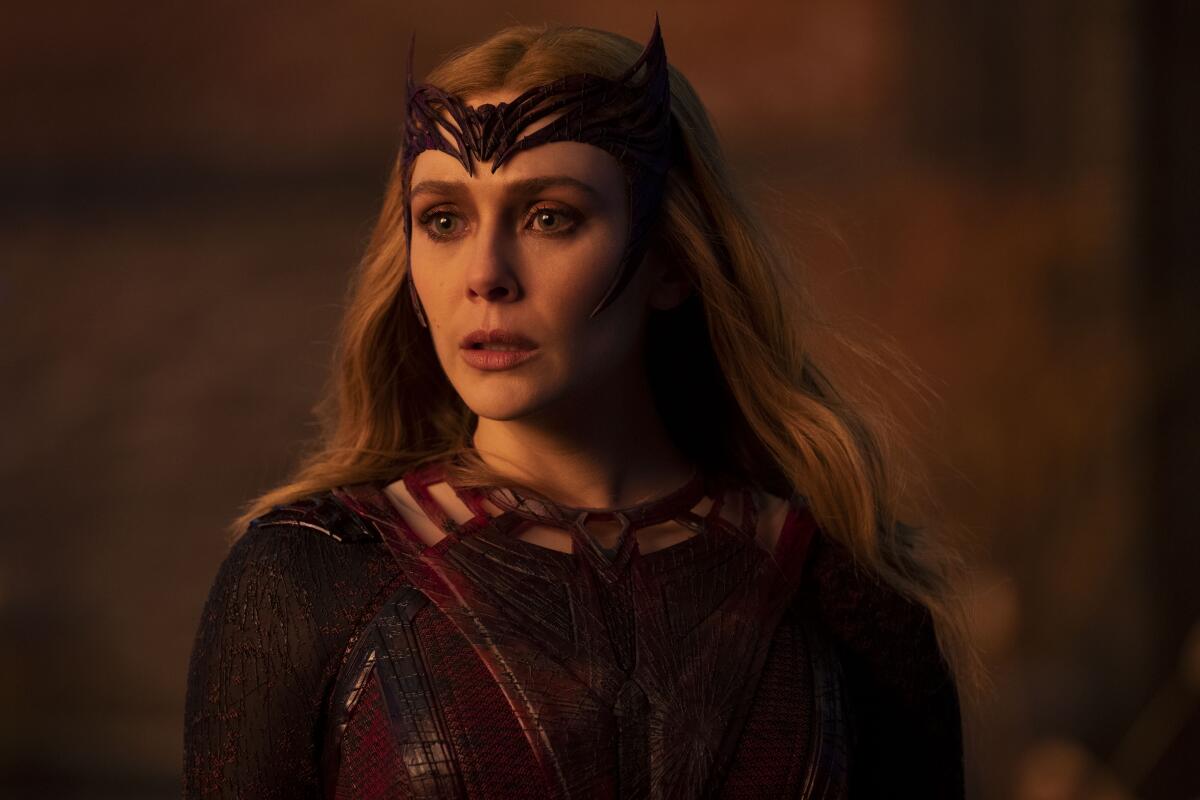
Wanda reminds you of Raimi’s long-standing affinity for witches, even if some of his haggard creations have been more memorable (Lorna Raver’s old crone from “Drag Me to Hell”) than others (the three witches from the inaptly titled “Oz the Great and Powerful”). Happily, he has a terrific performer here in Olsen; with fiery magenta eyes and a devil-horned tiara, she’s chillingly persuasive as a woman so devastated by her grief that she’s willing to inflict her own brutal casualties in order to overcome it. Building on the stealth emotionalism of her “WandaVision” arc, Olsen does possibly her most impressive work since her stellar debut in the 2011 independent drama “Martha Marcy May Marlene,” in which she also played a woman dangerously susceptible to the pull of mad, malevolent forces.
So emotionally dominant is Olsen here that Cumberbatch’s Strange sometimes feels less like a hero than a villain’s foil, which is honestly all to the good. Strange’s mission is simply to prevent Wanda from succeeding in hers, and to that end he’ll team up with a mysterious, multiverse-traveling newcomer, America Chavez (Xochitl Gomez, appealing if bland), who soon sends them flying through one interdimensional portal after another. (The various alternate universes, including a flower-forward vision of New York, are the standout elements of John Mathieson’s cinematography and Charles Wood’s trip-tastic production design.) Along the way, he also leans on some familiar faces, including his wizardly colleague Wong (the invaluable Benedict Wong); his old frenemy Baron Mordo (Chiwetel Ejiofor); and an alternate version of Christine who serves as a pesky reminder that love really is the most inescapable force in the multiverse.
Through the multiverse they go, crashing through various distorting and dreamlike mirrors — a cosmic labyrinth in which Strange and Wanda, in particular, will come face to face with a doppelgänger or two. Those surreal face-to-face confrontations allow the filmmakers to pose a few playful questions about fate, predestination and human decency: What binds us to our alternate-universe counterparts, and what sets us apart from them? Which recurring cycles can we break, and which mistakes are we doomed to repeat? These are rather different questions from the ones posed by the year’s other multiverse extravaganza, “Everything Everywhere All at Once,” and they land with particular force for Strange, who benefits, as ever, from Cumberbatch’s chronic unwillingness to seem too likable. Arrogance, cynicism and self-doubt become this Doctor Strange, initially obscuring — and then gradually revealing — his fundamental decency.
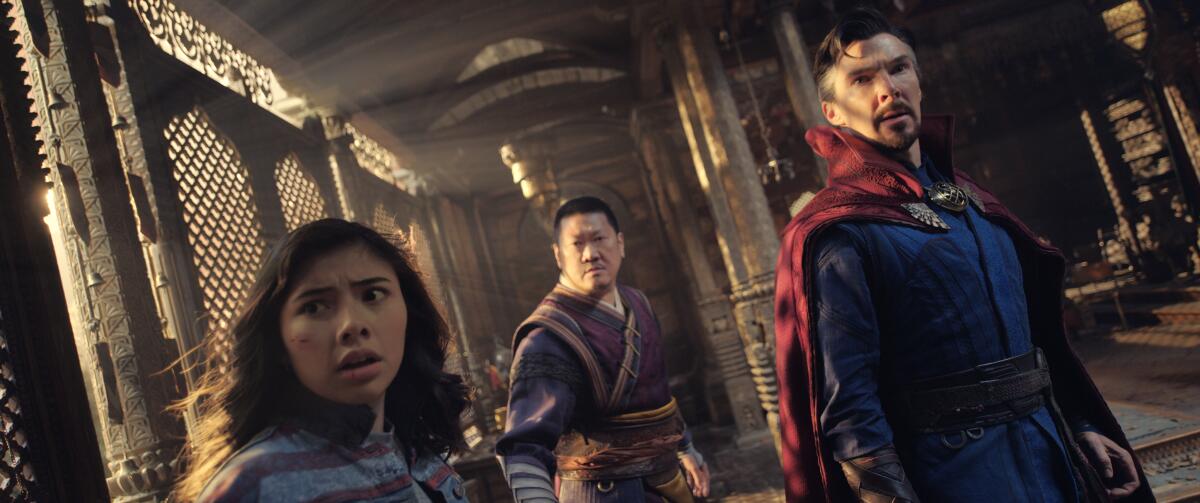
There’s still more: occult rites and ancient runes, high-altitude sanctums and acid-washed visuals, plus a bevy of out-there cameos that Raimi uses to poke fun at the elasticity of the multiverse. (It’s hardly a spoiler to note that it wouldn’t be a Raimi film if his favorite muse, Bruce Campbell, didn’t turn up in a scene or two.) There are also some deliciously pustular visions, including a few zombie- and wraith-like denizens who wouldn’t look out of place in Raimi’s “Evil Dead” movies. If Scott Derrickson, the director of 2016’s “Doctor Strange,” teased out the altered states and Far East mysticism in Steve Ditko and Stan Lee’s original comic books, then Raimi has found in this sequel a surprisingly accommodating vehicle for his ecstatic love of horror filmmaking (to say nothing of a darkly exultant score by Danny Elfman).
Raimi’s sheer passion for his material can sometimes overwhelm the coherence of his storytelling, and his unfashionable sincerity doesn’t always mesh with the breezy quip-a-minute tone that is the Marvel enterprise’s preferred comic idiom. I mean those both as compliments. Some overly busy cross-cutting and a few flubbed punchlines are a small price to pay for a filmmaker with enough of a vision to make you briefly forget that you’re watching another assembly-line product. That may not sound terribly inspiring, but in the context of an overall series where movie magic seizes hold only in fits and starts, it can feel downright heroic.
‘Doctor Strange in the Multiverse of Madness’
Rating: PG-13, for intense sequences of violence and action, frightening images and some language
Running time: 2 hours, 6 minutes
Playing: Starts May 6 in general release
More to Read
Only good movies
Get the Indie Focus newsletter, Mark Olsen's weekly guide to the world of cinema.
You may occasionally receive promotional content from the Los Angeles Times.

